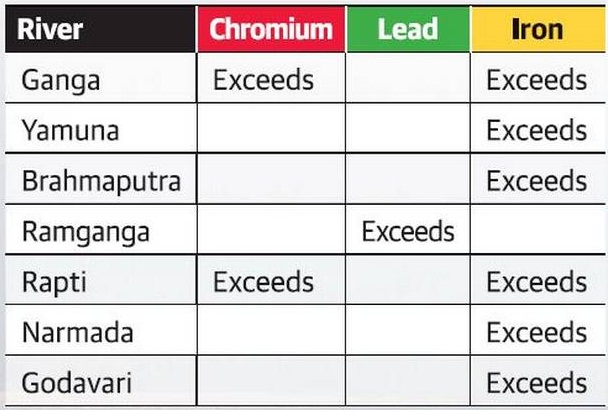Heavy Metals Contaminating India’s Rivers | 12 Dec 2019
Why in News
Recently, the Central Water Commission (CWC) has reported that the samples from two-thirds of the water quality stations spanning India’s major rivers are contaminated by one or more heavy metals, exceeding safe limits set by the Bureau of Indian Standards.
- The samples from only one-third of water quality stations were safe whereas 65% were polluted by heavy metals.
- Heavy metals are naturally occurring elements that have a high atomic weight and a density of at least 5 times greater than that of water.
- The exercise was limited to surface water and did not cover groundwater contamination.
- The presence of metals in drinking water to some extent is unavoidable and certain metals, in trace amounts, are required for good health. However, when present above safe limits, they are associated with a range of disorders.
- Long-term exposure to the heavy metals may result in physical, muscular, and neurological degenerative processes that mimic Alzheimer’s disease, Parkinson’s disease, muscular dystrophy and multiple sclerosis.
Key Points
- Iron emerged as the most common contaminant with above safe limits across the country.
- Arsenic and zinc are the two toxic metals whose concentration is always found within the limits.
- Arsenic contamination is a major environmental issue that affects groundwater.
- The other major contaminants found in the samples were lead, nickel, chromium, cadmium and copper.
- The contamination of water sites depends on the season. As the varied presence of contaminants is found in different seasons. Thus, the water samples were collected in three different seasons: Non-Monsoon, and Monsoon.
- Non-Monsoon Period: Lead, cadmium, nickel, chromium and copper contamination were more common in this period.
- Monsoon Period: Iron, lead, chromium and copper exceeded ‘tolerance limits’ in this period most of the time.
Reasons for Contamination of Surface Water
- The main sources of heavy metal pollution are mining, milling, plating and surface finishing industries that discharge a variety of toxic metals into the environment.
- The population growth and rise in agricultural and industrial activities are also responsible for contamination of surface water.
